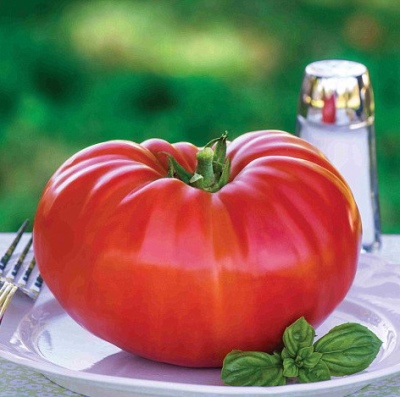
- Category: grade
- Growth type: semi-determinant
- Appointment: fresh consumption, for juice, for ketchup and tomato paste
- Ripening period: mid-early
- Ripening time, days: 105-110
- Growing conditions: for open ground, for film greenhouses
- Marketability: high
- Bush size: undersized
- Bush height, cm: up to 100
- Ripe fruit color: Red
Berdsky large tomato is one of the most large-fruited semi-determinant varieties of the Siberian collection, intended for growing in greenhouses and in the open field. Tomato is distinguished by unpretentiousness, high marketability, balanced taste, its fruits are consumed fresh, in the form of salads, for cooking sauces, making tomato paste and juices.
Description of the variety
A low-growing bush, no higher than one meter, has a branched root system, a compact shape. Shoots are covered with medium-sized, dark green leaves with slight pubescence. The plant grows well and bears fruit in areas of risky farming in the open field, manages to "stretch" large tomatoes to full ripeness in a short summer, if the gardener uses the seedling method.
The main qualities of the fruit
Large flat-round fruits weighing up to 700 grams change color from green to bright red at the stage of technical ripeness. There are few seed chambers; they all contain a limited number of seeds.
Taste characteristics
Tomatoes have a balanced sweet taste combined with a slight sourness. The fleshy pulp, sugary at the break, has a pleasant delicate characteristic aroma.
Ripening and fruiting
Berdsky large belongs to the mid-ripening group of tomatoes, the ripening period is from 105 to 110 days.
Yield
A productive variety gives up to 3 kg per bush, up to 10-14 kg per 1 m2.
The timing of planting seedlings and planting in the ground
Seeds for seedlings are planted using the classical method and at the time traditional for mid-early tomatoes - mid-late March. The plant is planted in greenhouses in mid-May, and in open ground after the threat of return frosts has passed and the ground warms up to + 15… 17ºC.

Growing tomato seedlings is an extremely important process, because it largely depends on whether the gardener can harvest at all. All aspects must be taken into account, from seedbed preparation to planting in the ground.
Landing scheme
The optimum planting density is 3, maximum 4 plants per 1 m2.

Growing and care
To optimize the cost of seeds, fertilizers, physical labor, and get a good harvest, you need to follow agrotechnical rules. Tomatoes are grown in seedlings, and to obtain strong seedlings, you will need not only special soil, but also providing a sufficient amount of light. If natural light is not enough, supplemental lighting with phytolamps is necessary, otherwise the plants will begin to stretch and weaken.For planting in a permanent place, ridges are prepared, the soil is enriched with organic matter and mineral fertilizers, wood ash must be added, river sand is added as necessary.
Humus, compost or bird droppings are added to the holes, superphosphate is added and stakes are installed in advance for support. After planting, the soil around the stem is compacted, spilled with settled warm water, and loosened the next day. Further care for tomatoes: timely watering, weeding, tying as it grows, the formation of a bush of 1-2 stems. This will reduce the number of inflorescences and ovaries, but will allow for larger, higher-quality fruits. The obligatory but tedious process of loosening can successfully replace mulching. Watering is carried out regularly until the ripening period, then stop. Until then, tomatoes are moistened approximately every 3-4 days, depending on the condition of the soil. The first feeding is applied during a set of vegetative mass and flowering, when the plants are in strong need of nitrogen. During the budding period, phosphorus-potassium fertilizers are used. Tomatoes respond gratefully to nutrition in the form of infusion of mullein, nettle and weeds with the addition of bread leftovers.




A plant needs different micronutrients at each stage of growth. All fertilizers can be divided into two groups: mineral and organic. Folk remedies are often used: iodine, yeast, bird droppings, eggshells.
It is important to observe the rate and period of feeding. This also applies to folk remedies and organic fertilizers.
Disease and pest resistance
The variety resists some diseases well, is tolerant to others, so it is imperative to engage in prevention. The use of fungicides will help to avoid fungal infections and the tobacco mosaic virus, insecticides will help to cope with such pests as naked slugs, aphids, spider mites and others. Airing, pinching, removing the lower leaves will relieve late blight.


Resistant to adverse weather conditions
The Siberian aborigine copes well with the unpredictable weather in the northern regions. The tomato has excellent stress resistance, it tolerates heat and cold snaps well.
Growing regions
The variety was bred for Siberia and adapted to its harsh conditions, therefore it is cultivated by gardeners of the Ural, West Siberian, East Siberian, Far Eastern regions.

























































































